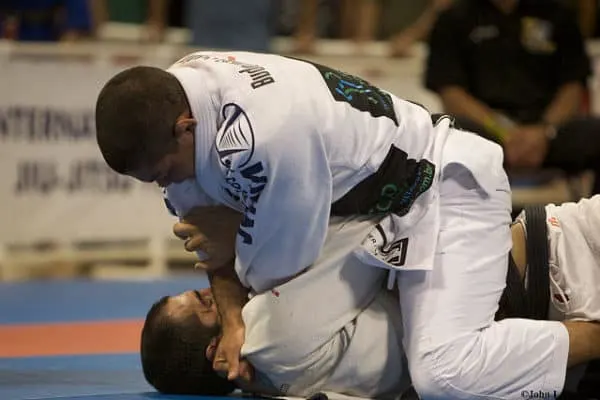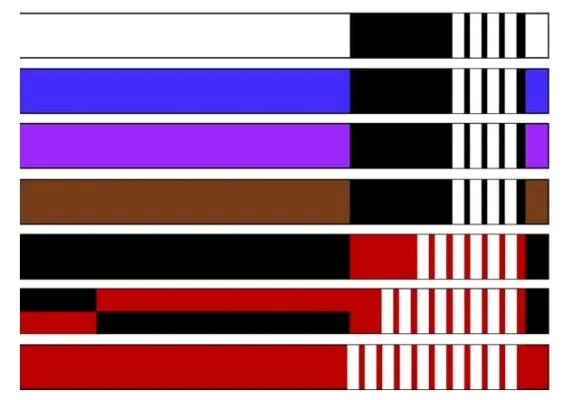
Learning a new martial art can be a daunting process and it is difficult to gauge if you are progressing at an acceptable pace. If you are considering learning Brazilian Jiu-Jitsu(BJJ), you may be wondering how long it will take you to learn the techniques. In this article you will find answers to the common questions people have about how long it takes to learn BJJ for beginners.
The Gracie Combatives program, which teaches BJJ beginners basic self-defense, takes 108 days. However, through the belt system, graduating from beginner to blue belt takes 2-3 years. However, those with prior grappling experience can achieve this much quicker as there is no minimum time frame.
I will explain these beginning stages of BJJ in more detail below. You will also find more common questions, including how often you should train and how you can speed up your progress.
How Long Does it Take to Learn BJJ for Self Defense?
The Gracie family, the founders of BJJ, recommend that beginners start their self-defense training with the Gracie Combatives program. Although BJJ consists of over 600 different techniques, the Gracie family recognized that there are 36 core techniques that will equip you with the skills required to defend yourself against any attacker. This self-defense program was originally developed for the U.S. army.
The program can be completed at your own pace, as long as you are proficient in all 36 techniques. The recommended training schedule for this is 108 days. However, this assumes you are learning one technique every three days. If you learned one technique every day, you could complete this course in just over a month (36 days).
This course is the minimum requirement for self-defense in BJJ. However, if you are training in BJJ at your local gym, you will be trained following the BJJ belt system. According to Helio Gracie, reaching your blue belt provides you with enough knowledge to defend yourself against any untrained attacker. Graduating to blue belt usually takes longer than the basic Combatives program, which I will explain in more detail below.
Is BJJ Hard to Learn?
BJJ is a martial art that was originally designed for anyone to learn, regardless of their weight, size or fitness level. In this regard, it is not hard to learn because there are no prerequisites and it does not rely on your own strength. However, BJJ does require patience, hard work and discipline if you want to be good.
Instructors will often teach a technique in one class, allow time to practice, and then move onto to another technique by the next class. This puts the responsibility on the student to practice these techniques between classes.
In addition to this, if you are attending three sessions per week, learning a new technique each time, it will still take years to master every Jiu-Jitsu technique. For this reason, it is expected that BJJ practitioners will undergo individual study to learn new techniques.
Therefore, despite the fact that BJJ is not physically hard to learn, the total commitment required to further develop your technique can be hard for some individuals.
LEARN MORE Get the full report on Is BJJ Hard To Learn?
Can You Learn BJJ in a Year?
If you are learning BJJ for self-defense only, you can become proficient in the 36 core Gracie Combatives in less than a year, as mentioned above. However, if you want to become a black belt, or ‘professor’ in BJJ, this cannot be done within a year.
Through the International Brazilian Jiu-Jitsu Federation (IBJJF), becoming a black belt will take a minimum of three years, although that is incredibly rare. There are even exceptions to this rule, which I will discuss further down, but graduating to black belt typically takes 10-15 years.
However, it is possible to receive your blue belt within a year. There is no minimum time frame required to graduate from a white belt to a blue belt. If you only want to learn how to defend yourself against an untrained attacker, earning your blue belt will achieve this.
How Many Times a Week Should I Train BJJ?
The Gracie Combatives program recommends learning a new technique every three days to keep up with their training schedule. With this in mind, you should be training in Jiu-Jitsu 2-3 times per week, or ten sessions per month. Training three times per week will allow you to have one day of rest between each session.
For a world champion such as Marcus Almeida, a typical week of training consists of 3-4 days every week with his coach. However, some practitioners may train up to six days individually. The reason Almeida’s coach does not train with him any more than 3-4 days is that it allows his body time to recover. Training too many times during the week can cause you to burn out and be detrimental to your progress.
How Long Does it Take to Get a Blue Belt in Jiu-Jitsu?
There is no minimum time frame to receive your blue belt. However, children practicing Jiu-Jitsu cannot receive their blue belts until they are 16 years old. On average, a person will take 2-3 years to receive their blue belt.
In the meantime, a white belt will receive ‘tips’ or ‘stripes’ on their white belt to measure their progress. In total, you will receive four stripes before graduating to your blue belt, with each stripe taking approximately 3-6 months. However, this varies significantly depending on the student’s dedication to their learning.

One of the quickest people to receive their BJJ black belt is Travis Stevens, who went from a white belt to black belt in 18 months under John Danaher. Stevens was promoted from his white belt to blue belt in just a number of weeks. This was made possible by Stevens’ history as a Judo Olympian as well as his dedication to BJJ training with Danaher. Judo and BJJ share many similar techniques that would have prepared Stevens for the basics of BJJ.
To receive a blue belt, students must be able to apply the techniques of BJJ from all major positions on the mat. These major positions include guard, side control, knee-on-belly, mount, rear mount and turtle. Also, as a general rule of thumb, if you are able to submit other blue belts, you are likely to be close to your blue belt promotion.
How Do I Get Good at BJJ Fast?
There are three key things you should do to speed up your progress as a BJJ practitioner, outlined below.
Train Regularly
As I mentioned earlier, training three times every week will give you the opportunity to learn new techniques from your instructor, while giving your body the break it needs to recover. Training with an instructor is important in receiving feedback and correction. Sometimes you may think you understand a technique, but there are fine details that you have missed that may allow your opponent to escape your pin or allow them to submit you.
Attend Open-Mat Sessions
Attending open-mat sessions will give you the opportunity to practice your techniques in a live grappling situation. You can also roll with people of different experience levels. Rolling with more experienced students will allow you to learn new techniques. Rolling with people with similar experiences will give you a chance to practice your techniques in an evenly-matched situation.
It is also important to roll with people who are less experienced than you. This will give them the opportunity to learn, but will also allow you to practice explaining your techniques to others. This helps to solidify your theoretical knowledge.
Independent Study
Self-directed learning is one key aspect to progressing faster in your BJJ career. Watching instructional videos will expose you to more techniques than your instructor can teach you in a short period of time.
Breaking down BJJ matches will also help you identify techniques that are effective on the mat. If you are able to learn techniques that are used by world-class BJJ competitors, you know that they are good techniques to learn.
Can You Learn Jiu-Jitsu by Yourself?
You cannot become fully competent in Jiu-Jitsu by yourself. You need to be able to practice your techniques with another person so that you understand how their body moves in response to your own. Without someone to practice with, you also will not be able to identify any flaws in your technique, which could be detrimental in a real fight situation.
In saying that, you can still learn the theory behind each technique through instructional videos and by practicing the basic body movements required. For example, in the Gracie Combatives program, students who are learning on their own are instructed to practice triangle choke on their legs instead of a partner’s neck.
How Many Techniques are there in BJJ?
There are currently over 600 techniques in BJJ. It is difficult to define an exact amount because new techniques are continually being developed over time. These techniques can be divided into five major categories, including takedowns, positions of control, submissions, escapes, guard passing and guard retention.
As I mentioned earlier, 36 of these techniques are considered crucial in self-defense against an untrained attacker. The remaining techniques will help you to defend against an experienced attacker, or will prepare you for competitions.
How Do You Remember BJJ Moves
Everyone has a different learning style. However, there are some general tips that will always help you to remember BJJ moves, outlined by black belt Andre Galvao.
- Drilling the technique
- Taking Notes
- Watching Videos
Drills involve repeating the technique multiple times with a partner, using little or no resistance. This allows you to build muscle memory for how your body needs to move.
Taking notes will allow you to remember the names of the techniques as well as little tips to remember the movements. For example, the ‘hitchhiker escape’ reminds practitioners to flick their thumb up, as a hitchhiker would, to escape an armbar.
Finally, watching instructional videos will solidify what you have learned. You can also pick up on any fine details you may have missed in your class.
